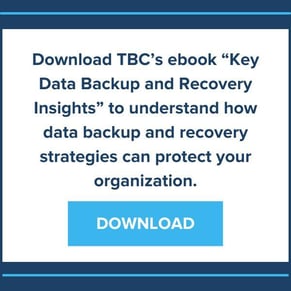
C-suite executives should have IT security and complete data backup solutions prepared long before disaster strikes. Threat actors are working hard to disrupt business operations to either demand ransoms or inflict the most significant possible damage on organizations. Targeted digital attacks can happen at any time to any organization. Data backup and Disaster Recovery preparation are essential to stop, contain, recover, and restore operations.
A solid and tested disaster plan will allow executives and IT decision-makers to react quickly and with authority, saving time, money, and brand reputation. Companies can't afford to wait for disaster to strike. Preparation is vital to protect digital infrastructures during unplanned incidents.
IT disasters can create unpredictable outcomes. Although you may be unable to anticipate an attack by ransomware or other catastrophic events — effective backup and disaster recovery plans can help protect your company during times of uncertainty.
Don't be the one who waits until it's too late, forced to delegate tasks and build a plan while your organization is crumbling beneath your feet. Having a recovery strategy in place ahead of time can allow your business to respond appropriately to disasters and emergencies.
#1. Establish Acceptable Recovery Time Goals
Returning to standard operational functionality after a disaster is critical for ensuring business continuity. But determining acceptable Recovery Time Objectives (RTO) and Recovery Point Objectives (RPO) can be a hurdle for many organizations. RTO is the time it takes your organization to restore data. RPO is the time between backups. The greater the RPO, the more data you are likely to lose.
While many companies may think immediate and complete data restoration is necessary—the potential costs for quick solutions can be astronomical. Recovery timeframes depend on multiple factors as defined in your business continuity plan.
Establishing disaster recovery time goals is vital for meeting backup objectives within specific timeframes. While some businesses need continuous data recovery and support — daily or weekly recovery strategies will work for others. Your data backup and disaster recovery strategy should be customized to your organization and framed by standards within your industry.
Assessing the specific needs of your business will define your company objectives and strategy. Performing a cost/benefit analysis of different methodologies can help you create a plan best suited to meet your organization's needs.
Download our ebook, "Key Data Backup and Recovery Insights," to understand how data backup and recovery strategies can protect your organization.
#2 Choose Appropriate Technology
Many companies have the tools, resources, and digital capacity to back up and restore their data and applications, but only some do it correctly or consistently. Having the right software and hardware in place can help companies protect assets during times of uncertainty. Not only do you need cutting-edge technologies, but you also need to define processes around those technologies.
Critical operational data will necessitate real-time data backups, but less essential data and applications can wait until the crisis subsides. Even without a ransomware attack, your data can be lost, damaged, or accidentally deleted and have the same downtime impacts as a data breach by a threat actor.
If you contract with a third party for data backup and disaster recovery solutions or DYI, follow a 3-2-1 backup strategy:
3 copies of your data, on 2 different storage devices, with 1 copy at an offsite location.
Offsite backups are essential to protect against natural disasters and to isolate data from the network. Maintaining multiple copies of your data is work as they must be continuously updated and your software maintained with security patches and updates. If you need more time and resources to maintain your backups, seek a trusted third party to take over your data responsibilities.
#3 Establish Geographical Remote Site Locations
Geo-redundancy is the distribution of your data across multiple geographic locations and is part of a healthy backup and recovery strategy. Using Geo-redundancy will help protect your critical data and applications. Selecting data center locations for disaster recovery solutions will provide fail-over recoverability in a natural disaster.
Planning for effective recovery solutions is a delicate balance between criticality, availability, accessibility, and costs. Data backup specialists can help you determine your best path for cost-effective recovery options. Cloud-based backup solutions also provide easy-to-access-from-anywhere backup solutions.
#4 Create Backup Processes and Procedures for Data Recovery
Failure to prepare for a disaster can wreak havoc on any organization. Defining and practicing recovery procedures can help speed up resolution and restoration times while minimizing negative financial impacts.
As part of your disaster recovery strategy, define roles and responsibilities, backup processes, the chain of command, a communication tree, and the order in which systems and data need to be restored. Department heads should receive training in their duties ahead of time to minimize stress and uncertainty.
Executives should agree on which business operations and data are most critical. Those decisions help expedite disaster recovery and eliminate time-consuming infighting during a crisis.
#5 Perform Routine Data Backup and Recovery Verifications
Data backup and recovery tests should be performed regularly—at least annually, if not quarterly. Verifying that all data and applications have restorable backups can minimize recovery times. Although verification testing can be time and resource intensive, they are vital to disaster preparation and will build confidence in your team's ability to recover.
Performing ongoing testing can better prepare your IT teams to react and respond appropriately in the chaos of a disaster. By documenting testing processes and results, you can anticipate realistic restore times and data recovery success rates and learn from failures. Addressing all potential vulnerabilities will help improve your recovery strategy.
Let TBC Help Create and Implement Your Data Backup and Recovery Plan
Being adequately prepared for disasters can help businesses survive with minimal long-term impact. Partnering with a reputable third-party company can improve flexibility within your organization while allowing you to achieve your data backup strategy goals.
TBC's data backup and disaster recovery solutions are essential elements of Business Continuity planning. As data loss and downtime are the enemies of growth and profitability, our certified data experts prioritize and test data and workflow recovery methodologies so that we can restore business operations quickly.
TBC's cloud-first backup strategy empowers clients to mitigate risk and increase compliance while reducing the impact of an inevitable attack. Following our SOC2 compliance requirements, we understand that working to protect client data requires keeping discretion, privacy, and security top of mind.
Our Veeam-certified data engineers and architects love data backups and are driven to provide service excellence. With our data team working in the background of your business, you can rest easy knowing your business-critical data is safe, secure, and restorable.
.png)



